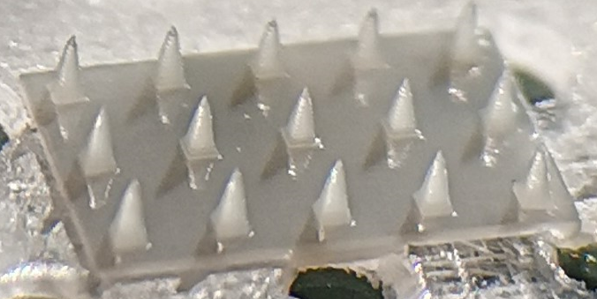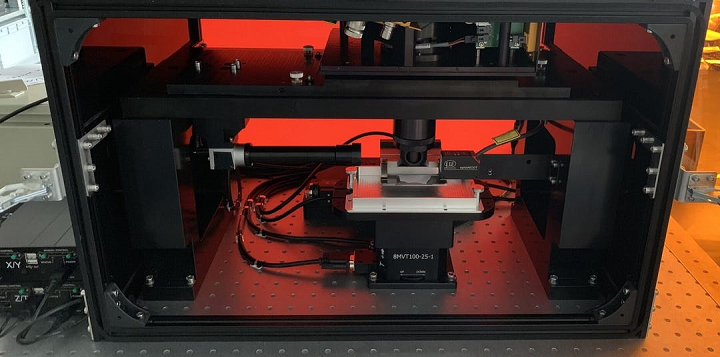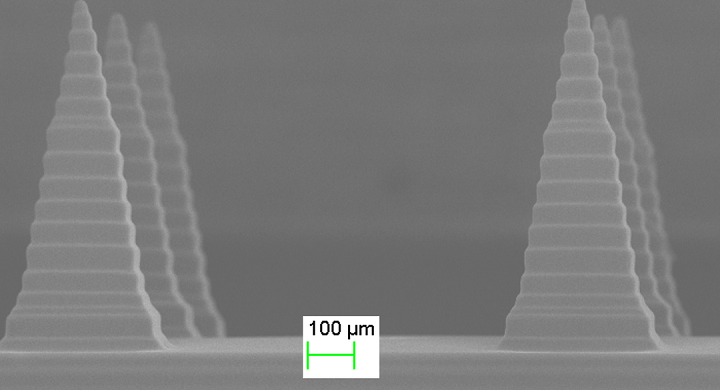Around the globe, 422 million people have diabetes, which means many of them need to monitor their daily glucose levels by pricking their finger to test the blood. I can’t imagine this is all that fun, and I can’t believe that there doesn’t seem to be a better solution. But the Austrian Institute of Technology (AIT) is working with In-Vision and DIRECTSENS to try and make the process more comfortable by using a novel 3D printed microneedle solution for glucose monitoring.
Together, the three organizations have launched the NUMBAT research project, funded by the Austrian Ministry for Climate Change through the Research Promotion Agency FFG and with a mission to develop a proof of concept printer that uses high-resolution DLP 3D printing to create a polymeric microneedle array for less painful and invasive continuous glucose monitoring (CGM).
The NUMBAT team knew that in order to deliver, they would need microneedles, metallization to define electrodes for electrochemical measurements, and a biofunctionalization layer: a surface modification that ensures glucose detection with direct electron transfer to the electrode. These components are put on a flexible foil that can be applied to a person’s skin and provide real-time glucose level monitoring just below the surface of the skin, without reaching blood vessels or nerves—making the CGM process more comfortable. They could use a conventional metallization process, but novel solutions would be needed for the microneedles and biofunctionalization layer.
In order to generate a signal when glucose is detected in a blood sample, traditional finger-prick glucometers, like the one above, use glucose oxidase, and the electronic signal is then delivered to the electrode through partially toxic mediators, which is generally not an option for less invasive monitoring. That’s why biosensor company DIRECTSENS is a part of the project: its technology can enable a safer direct electron transfer enzyme biofunctionalization, so the team can lower the necessary voltage to operate the biosensors, which in turn allows for a longer life and reduces interferences.
Conventional technology wouldn’t cut it for printing extremely small microneedles, specifically 500 micron (0.5 mm) high ones with a 2-micron wide tip. Micro-injection molding isn’t flexible or inexpensive enough to customize the microneedle layout multiple times for experiments, and TPP 3D printing is also pretty costly, as well as very slow. Instead, the team went with DLP-based microstereolithography for its flexibility, speed, and accuracy in both experimentation and substrate materials. Here’s where In-Vision comes in, as the Austrian startup, known for its industrial light engines, offered up its Firebird UV DLP Projector, which features a custom lens design, 2560 x 1600 micron native resolution, and a 2-micron pixel-pitch.
“The high resolution of the light engine was the critical factor. With its 2-micron pixel resolution and optical design, the projector was beyond the state of the art that we needed to enable and further the development process,” explained Giorgio Mutinati, senior research engineer, molecular diagnostics, in the Center for Health and Bioresources at AIT.
In-Vision’s Firebird projector was able to achieve the necessary customization and precision that NUMBAT needed, and the startup also helped AIT build the printer and program the software as well.
“In addition to the projector, the In-Vision LabVIEW-based software was a core part of the project. In-Vision worked with us to build up the system within our specifications and continue to support us in this project,” Mutinati continued.
If the proof of concept ends up being successful, it could pave the way to developing personalized microneedle arrays, and other applications like hollow needles for intradermal drug delivery. As NUMBAT has reached Technology Readiness Level 4, and the team prepares to demonstrate how capable its solution is at the biosensor level, they’re also getting ready to continue exploring the 3D printing process they created together.
“The high-resolution capabilities of this printer give us so many options, and we’re looking for partners to further exploit this technology through additional research on needles and various needle geometries. The competitive speed and flexibility of the technology open the door to many new and novel applications,” Mutinati concluded.
(Source/Images: In-Vision)
Subscribe to Our Email Newsletter
Stay up-to-date on all the latest news from the 3D printing industry and receive information and offers from third party vendors.
You May Also Like
Further Understanding of 3D Printing Design at ADDITIV Design World
ADDITIV is back once again! This time, the virtual platform for additive manufacturing will be holding the first-ever edition of ADDITIV Design World on May 23rd from 9:00 AM –...
3D Printer Maker EVO-tech Reborn as NEVO3D — Once More With Feeling
EVO-tech was a 3D printing service and original equipment manufacturer established in 2013 and based in Schörfling am Attersee, Austria. The company produced high-quality material extrusion systems featuring linear bearings,...
3D Systems Brings 3D Printed PEEK Cranial Implant to the U.S. with FDA Clearance
For more than 10 years, 3D Systems (NYSE:DDD) has worked hand-in-hand with surgeons to plan over 150,000 patient-specific cases, and develop more than two million instruments and implants from its...
CDFAM Returns to Berlin for Second Annual Symposium
The second CDFAM Computational Design Symposium is scheduled for May 7-8, 2024, in Berlin, and will convene leading experts in computational design across all scales. Building upon the first event...





































